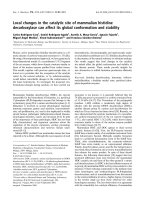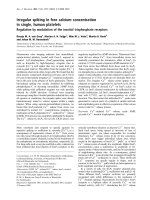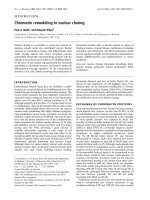Báo cáo y học: "Intranuclear changes in cancer cells" potx
Bạn đang xem bản rút gọn của tài liệu. Xem và tải ngay bản đầy đủ của tài liệu tại đây (49 KB, 3 trang )
Genome Biology 2007, 8:312
Meeting report
Intranuclear changes in cancer cells
David M Gilbert* and Daniele Zink
†
Addresses: *Department of Biological Science, Florida State University, Tallahassee, FL 32306, USA.
†
Ludwig-Maximilians-University
Munich, Department of Biology II, Grosshaderner Str., 82152 Planegg-Martinsried, Germany.
Correspondence: Daniele Zink. Email:
Published: 31 August 2007
Genome Biology 2007, 8:312 (doi:10.1186/gb-2007-8-8-312)
The electronic version of this article is the complete one and can be
found online at />© 2007 BioMed Central Ltd
A report on the FASEB meeting ‘Nuclear Structure and
Cancer’, Saxtons River, USA, 16-21 June 2007.
This year’s Federation of American Societies for Experimental
Biology (FASEB) conference on nuclear structure and cancer
opened with keynote speaker Donald Coffey (Johns Hopkins
University, Baltimore, USA), who together with Ronald
Berezney (University at Buffalo, Buffalo, USA) is credited with
the discovery of the nuclear matrix. Coffey pointed out that
changes in nuclear structure are diagnostic hallmarks of many
cancers that are frequently utilized by the pathologist but are
poorly understood from a molecular standpoint. This set the
tone for a stimulating meeting, where talks on the funda-
mental organization of the nucleus were intermingled with
reports of direct links to cancer and perspectives from
pathologists. There were many interesting talks and here we
report a few of the highlights.
Chromosomal organization and aberrations
How universal are the ‘rules’ of chromosome organization
within the nucleus that are so frequently abrogated in
cancer cells? Thomas Cremer (Ludwig-Maximilians-Univer-
sity, Munich, Germany) reported that in rod cells of the
retina of nocturnal animals, the heterochromatin is in the
center of the nucleus and euchromatin at the periphery,
which is the inverse of nearly all other cell types examined
to date. He speculates that this arrangement may be less
diffractive to light and might, therefore, provide an
advantage for nocturnal animals.
Live-cell imaging is now a standard tool in the analysis of
nuclear structure and function. Andrew Belmont (University
of Illinois, Urbana, USA) addressed the large-scale chromatin
organization of actively transcribing genes in somatic diploid
nuclei of living cells. In contrast to models proposing the
transition from loops of 30-nm chromatin fibers to 10-nm
fibers during transcriptional activation, Belmont finds that
transcribed chromatin remains several-fold more compact
than even the 30-nm fiber. How do transcription factors find
their cognate sites in these thick fibers? Gordon Hager
(National Cancer Institute, Bethesda, USA) emphasized the
highly dynamic nature of transcription factor binding as
illustrated by the implication of chromatin remodeling as a
key mechanism in nuclear receptor ‘hit-and-run’. He
described recent work addressing the question of whether
chromatin remodeling is always required for interactions of
the glucocorticoid receptor (GR) with its binding sites and
whether these are always dependent on Brg1, a component
of the chromatin-remodeling SWI/SNF complex. Genome-
wide analyses revealed that chromatin remodeling takes
place at all GR-binding sites, but is not always dependent on
Brg1. The results suggest that GR searches chromatin
randomly, but that chromatin remodeling distinguishes
functional and non-functional interactions. Hager also
pointed out that mapping of DNase I hypersensitive sites is
an important tool in the identification of functional
regulatory sites where chromatin remodeling takes place.
A common characteristic of tumor cells is genomic insta-
bility leading to chromosomal aberrations. For example,
aggregates of telomeres are frequently observed in the
nuclei of tumor cells but not in those of normal cells. Sabine
Mai (University of Manitoba, Winnipeg, Canada) reported
that expression of the proto-oncogene c-Myc leads to the
formation of telomeric aggregates and telomeric fusions.
She has found that the normal intranuclear positioning of
centromeres and chromosomes was disturbed in cells over-
expressing c-Myc, and that this was associated with the
formation of chromosomal aberrations. These nuclear
changes required the Myc box II domain of c-Myc, which
associates with the histone acetyltransferase (HAT) Tip60;
c-Myc overexpression in combination with Tip60
heterozygosity led to enhanced lymphoma formation in
mice. These findings suggest that c-Myc-induced changes in
nuclear organization play an important role in the genomic
instability associated with tumorigenesis.
Jeffrey Salisbury (Mayo Clinic, Rochester, USA) presented
an elegant study on the regulation of centrosome duplica-
tion. Centrosome amplification is often observed in tumor
cells and can lead to aberrant spindle formation and
chromosomal instability. Normally, centrosome
duplication is coordinated with the cell cycle. During the
cell-cycle arrest that follows DNA damage the protein
xeroderma pigmentosum C (XPC) becomes upregulated.
XPC binds to centrin 2, which is essential for centrosome
duplication, and the complex moves into the nucleus - a
movement dependent on the presence of the tumor
suppressor protein p53. This depletes the cytoplasmic pool
of centrin 2, and the resulting low levels are not sufficient
to support centrosome duplication. Salisbury has found
that in cells, such as tumor cells, that are defective in p53
function, or following post-transcriptional silencing of
XPC, the cytoplasmic pool of centrin 2 remains high
enough to support aberrant duplication, resulting in
spindle abnormalities and chromosome instability.
The relation between cell-cycle stage and vulnerability to
carcinogens was addressed by David Kaufman (University of
North Carolina, Chapel Hill, USA), who has shown
previously that cells are most susceptible to transformation
by chemical carcinogens when treated at the beginning of S
phase. He now reported that in two different human cell
types (normal fibroblasts and lymphoblastoid cells), genes
replicated at the beginning of S phase include the majority of
apoptosis genes and Wnt genes, both of which are frequently
associated with cancer. This suggests the existence of a class
of important cancer-related genes, located on several
different chromosomes, which are replicated simultaneously
during the cell cycle and are most vulnerable to cancer-
causing mutations during replication.
The organization of the sites at which DNA replication and
transcription take place within the nucleus and their
potential roles in the generation of chromosomal aberrations
associated with cancer were addressed in several presenta-
tions. James Davie (University of Manitoba, Winnipeg,
Canada) outlined work showing that transcription factors
Sp1 and Sp3, which are ubiquitously expressed in
mammalian cells, form distinct unrelated nuclear foci and
associate with histone deacetylase (HDAC) 1 and phos-
phorylated HDAC2. Using chromatin immunoprecipitation
(ChIP), he studied the binding of the estrogen receptor
alpha, Sp1 and Sp3 to the estrogen-responsive trefoil factor 1
promoter in MCF-7 breast cancer cells. The findings
suggested that Sp1 and Sp3 aid in recruitment of HDACs and
HATs. Spectral karyotype analyses revealed high chromo-
somal instability in MCF-7 cells and Davie pointed out that
the question of cell-to-cell variation in the karyotype of
cancer cell lines must be carefully addressed when perform-
ing ChIP analyses.
The importance of the organization of the transcriptional
regulatory machinery in nuclear microenvironments in
cancer was underlined by work presented by Gary Stein
(University of Massachusetts, Worcester, USA). He reported
that the NMTS domain of the Runx transcription factors is
necessary and sufficient for subnuclear targeting and
trafficking. Perturbations in subnuclear targeting of Runx1
(also known as AML1) are associated with altered compe-
tence for myeloid differentiation and with expression of the
transformed/leukemia phenotype in myeloid progenitors.
Impaired intranuclear trafficking of Runx2 (also known as
AML3) in metastatic breast cancer cells interferes with the
formation of osteolytic lesions in vivo.
Cameron Osborne (Babraham Institute, Cambridge, UK)
reported that immediate early genes, including c-Myc, are
recruited within minutes into transcription factories -
complexes of transcribing genes - upon B-cell stimulation.
He has found that 25% of transcribing c-Myc alleles
colocalize with the IgH locus. Other active loci did not show
a correspondingly high degree of association. Intriguingly,
c-Myc and IgH are the most frequent translocation partners
in mouse plasmacytoma and Burkitt’s lymphoma, suggesting
that intermingling of chromatin from the c-Myc and IgH loci
during co-transcription makes it more likely that these loci
will undergo translocations.
Epigenetic changes in cancer cells
In addition to genetic lesions, cancer cells display character-
istic epigenetic changes associated with altered gene-expres-
sion patterns, which include CpG island hyper- and hypo-
methylation. CpG island hypermethylation leads to
epigenetic silencing by recruiting methyl-CpG-binding
domain (MBD) family proteins. William Nelson (Sidney
Kimmel Comprehensive Cancer Center, Baltimore, USA)
reported that hypermethylation leads to epigenetic silencing
of the GSTP1 locus (encoding the π-class glutathione
S-transferase) in nearly all prostate cancers, and most breast
and liver cancers. High-throughput chemical screening has
yielded a number of compounds capable of activating
transcription from hypermethylated GSTP1 promoters, and
several of these compounds antagonized the binding of
MBDs to methyl-CpG-containing DNA. Nelson described a
strategy for characterizing methyl-CpG patterns based on
the binding of DNA to the DNA-binding domain of MBD2
and subsequent hybridization to whole-genome tiled arrays.
This approach has potential applications in cancer
screening, detection, diagnosis and prognosis.
A direct link between oncogene activation and diagnostic
nuclear changes in human papillary thyroid carcinoma cells
was reported by Andrew Fischer (University of Massachusetts,
312.2 Genome Biology 2007, Volume 8, Issue 8, Article 312 Gilbert and Zink />Genome Biology 2007, 8:312
Worcester, USA). Changes diagnostic of this type of cancer are
the dispersal of heterochromatin and irregularity of the
nuclear lamina. Activation of either of the tyrosine kinases Ret
or Trk is sufficient to induce the diagnostic changes in vitro.
Fischer reported that dispersal of heterochromatin is
associated with a decrease in monomethylation of lysine 4 of
histone H3, and that Trk is sufficient to induce this decrease.
Previous work from the laboratory of Donald Tindall (Mayo
Clinic, Rochester, USA) showed that the transcriptional co-
activator p300 is involved in the progression of prostate
cancer. At the meeting, Tindall reported that transfection of
p300 into prostate cancer cells induces quantifiable nuclear
alterations associated with prostate cancer. Furthermore, he
proposed the provocative idea that androgen ablation, a
routine treatment for prostate cancer, might initiate an
androgen-independent cycle of activity. This suggestion is
based on the findings that p300 mediates androgen-
independent activation of the androgen receptor and that
androgens downregulate p300 in cancer cell lines. Thus,
androgen ablation might increase p300 expression in
prostate cancer cells, which might initiate aberrant androgen-
independent activation of the androgen receptor. Androgen-
independent activation of the androgen receptor is usually
observed in refractory prostate cancer after androgen-
deprivation therapy.
The molecular basis by which alterations in nuclear
structure and function lead to cancer is unquestionably an
exciting new area for young researchers. Exchange between
clinicians and basic researchers in this field is still limited,
but is an inevitable prerequisite for investigating and
understanding nuclear changes in cancer. This biennial
meeting will continue to provide an exceptional forum for
such discussions between clinicians, pathologists and basic
researchers. The conference also provided a forum for
investigators from academia and the biotech and
pharmaceutical industries to explore cancer-related changes
in the organization and localization of regulatory machinery
within the cell nucleus as a platform for new diagnostic and
therapeutic strategies.
Genome Biology 2007, Volume 8, Issue 8, Article 312 Gilbert and Zink 312.3
Genome Biology 2007, 8:312









